FAQ's
FREQUENTLY ANSWERED QUESTIONS (FAQ)
- What is laser light therapy?
- How do lasers work?
- How long does it take to work?
- What does it feel like to get a laser treatment?
- How do you know it’s not causing cancer or other tissue damage?
- Are there any side effects?
- How do I prepare for a laser therapy treatment?
- Is there any research?
WHAT IS LASER LIGHT THERAPY?
Laser therapy is the application of low levels of laser light to areas of the body that have been injured or damaged. Another term used is ‘Cold’ laser therapy due to the non-thermal, non-burning effects. Contrasted with high-powered lasers used in health care that cut tissue, such as surgical or hair-removal lasers, cold therapy lasers produce beneficial photochemical and photobiological interactions that can help relieve pain and repair injured/damaged tissue.
HOW DO LASERS WORK?
The photons of laser light penetrate through your skin and are absorbed by special components in your body’s cells called chromophores. Just as photosynthesis creates energy for plants, the absorption of the photons by your cells causes increased production of cellular energy. In areas of injury or damage, this means there is more energy available to improve the rate and quality of healing. This is called biostimulation.
Because of its biostimulatory nature, laser therapy has the potential to help any scenario whereby the body’s cells are not working to their optimum potential. Studies on tissue cultures reveal a wide range of beneficial physiological effects, including increased levels of endorphins, prostaglandins and other beneficial components; reduced levels of harmful compounds including C-reactive protein and interleukin-1; pain modulation through a variety of mechanisms; and increased rate and quality of tissue healing.
Ok, but what does that mean in English? For patients, that means relief from acute and chronic pain, reduced inflammation and muscle spasms, improved range of motion and restored function. Patients suffering from headaches, neck pain, carpal tunnel, low back pain, sports injuries, post-surgical pain and more have been helped with laser therapy.
HOW LONG DOES IT TAKE TO WORK?
Some patients notice improvement after the very first treatment session; with others it may take more than a few treatments. The effect of laser light therapy is cumulative, meaning that each successive treatment builds on previous ones.
WHAT DOES IT FEEL LIKE?
Pain-free! You can feel nothing at all, or you may notice a tingling sensation in the treatment area as blood vessels dilate, or as muscle spasms are reducing in strength and duration. Laser therapy is virtually a painless treatment.
CAN IT CAUSE CANCER OR OTHER TYPES OF TISSUE DAMAGE?
No.
There are two ways that laser light can damage tissue; if it is very concentrated (high power density) or if the photons are very high energy. The ‘cold’ lasers that we use in our office use power densities that are far below the levels that cause tissue damage. Our cold therapy lasers use visible and near-infrared light, which only cause molecular vibrations.
ARE THERE ANY SIDE EFFECTS?
No.
Some patients may experience mild soreness in the area of treatment, as toxins are released and blood flow is restored. World experts on laser light therapy have commented that therapeutic lasers have no undesirable side effects in the hands of a qualified health professional. Laser light therapy is safe, painless and non-invasive.
HOW DO I PREPARE FOR A LASER LIGHT TREATMENT?
Laser therapy must be delivered directly to the skin for it to reach the appropriate cells. It does not pass through clothing. A gown will be provided when necessary.
When possible, wear loose fitting clothing. Make sure your skin is clean and avoid lotions, oils, skin creams and topical skin medications before appointment. These can create a barrier to the desired results.
In order to achieve better results, drink water before and after treatment.
HOW LONG DOES THE TREATMENT LAST?
This will depend on the area or areas that need treatment. Each person has individual needs. Depending on how big or small the area is, it also depends on how long the problem has been there.
HOW MANY TREATMENTS WILL I NEED?
Acute injuries typically respond quickly to treatment. Chronic conditions usually take longer. For example, if an injury occurred within the last 6 weeks, you may see significant reduction in pain and swelling in as little as 1-2 visits. If you have had the problem for years, it will generally take longer, from weeks to months.
IS THERE ANY RESEARCH?
Absolutely. Please email us for details.




